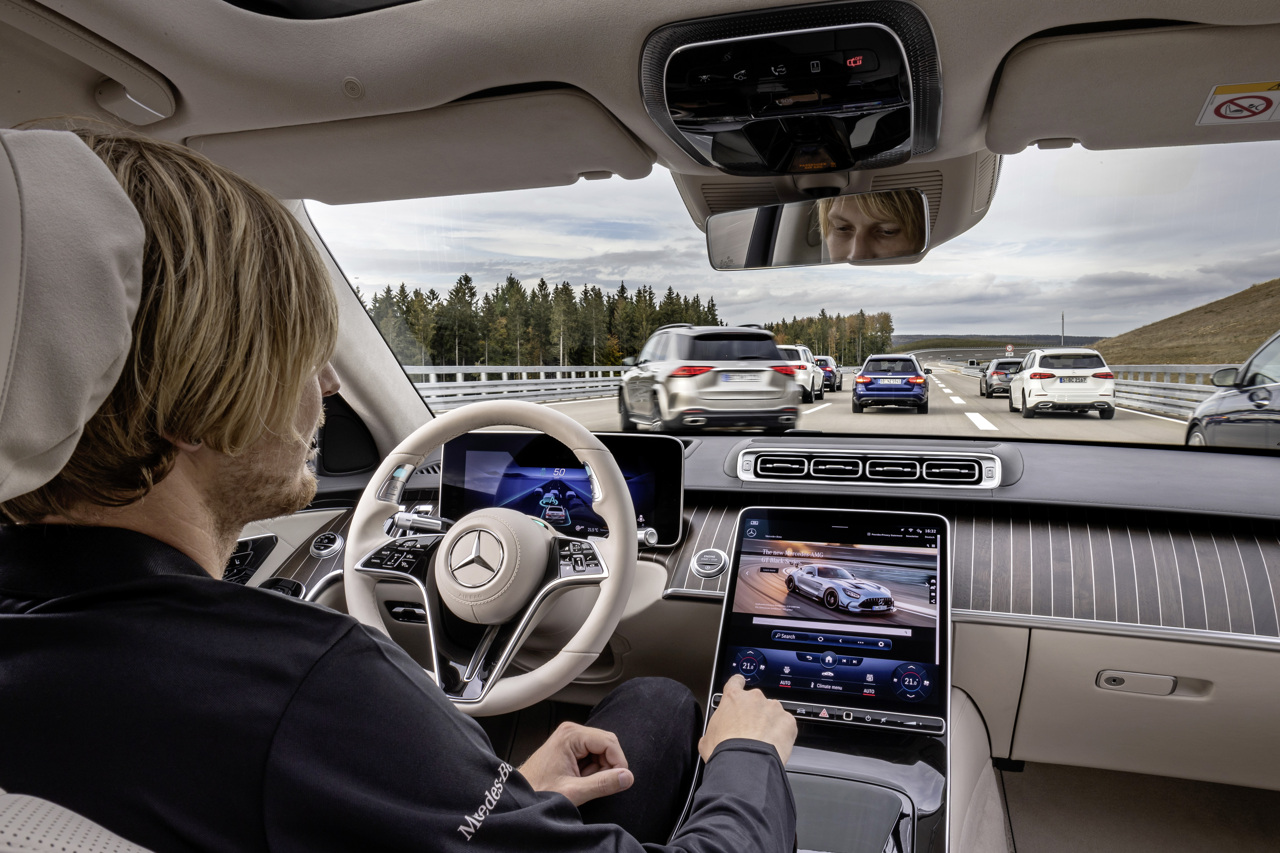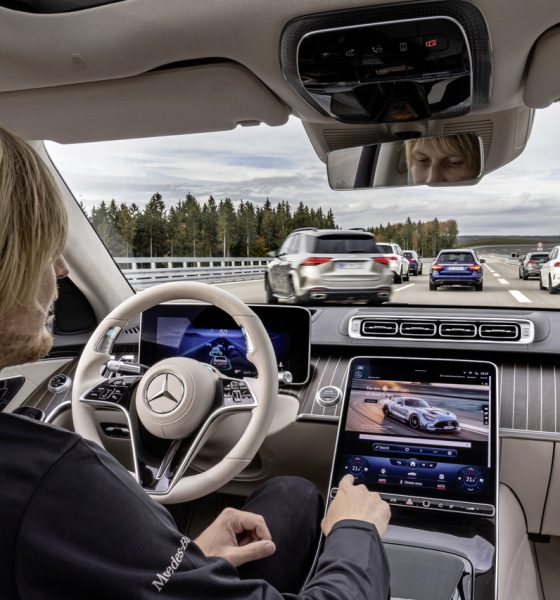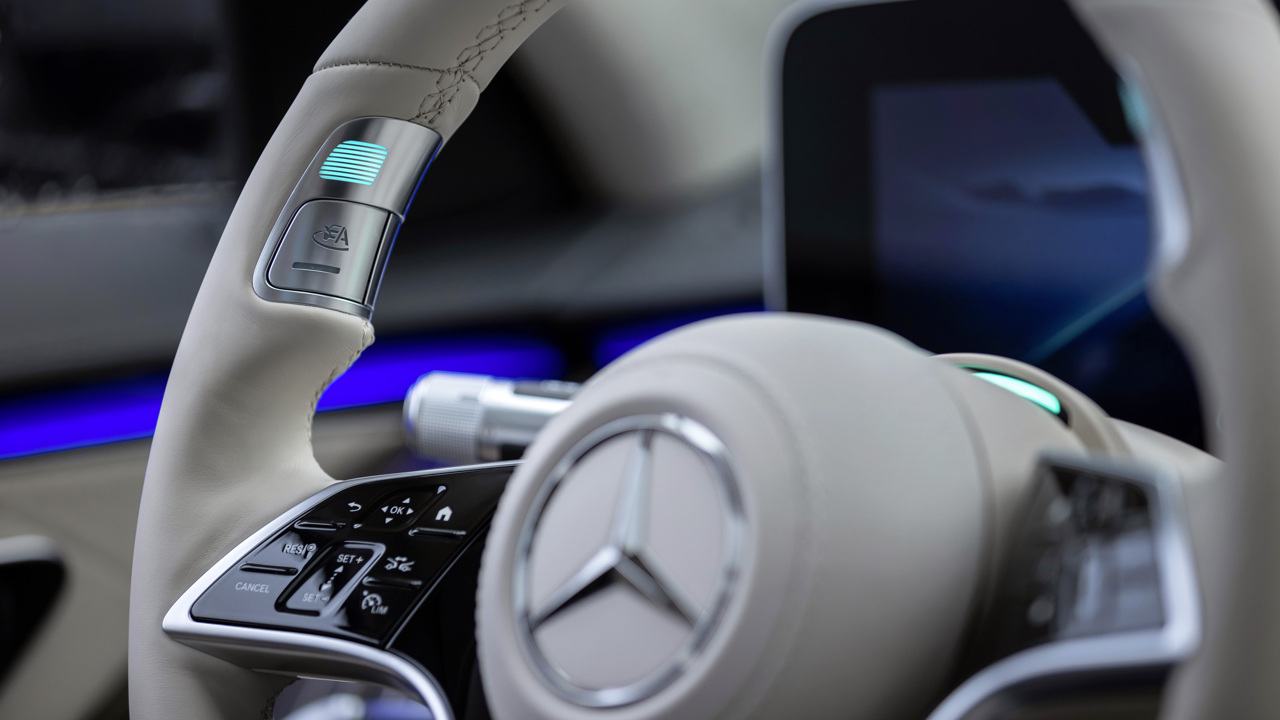

News
Mercedes-Benz DRIVE PILOT captures world’s first approval for hands-free driving
Mercedes-Benz DRIVE PILOT has captured the world’s first approval for ‘conditionally automated’ driving on German highways with its Level 3 system. The German automaker’s DRIVE PILOT is the first internationally valid system, as it met the requirements of Global Automotive Regulation No. 157, which concerns the approval of vehicles with regards to Automated Lane-Keeping Systems.
Mercedes-Benz announced the accomplishment, calling it proof of the company’s “pioneering work in automated driving.” The German Federal Motor Transport Authority granted the approval.
“For many years, we have been working to realize our vision of automated driving. With this LiDAR-based system, we have developed an innovative technology for our vehicles that offers customers a unique, luxurious driving experience and gives them what matters most: time. With the approval of the authorities, we have now achieved a breakthrough: We are the first manufacturer to put conditionally automated driving into series production in Germany,” Member of the Board of Management of Daimler AG and Mercedes-Benz AG, Chief Technology Officer responsible for Development and Purchasing Markus Schäfer said.
Die Bedienelemente für den DRIVE PILOT sitzen im Lenkradkranz oberhalb der Daumenmulden rechts und links. Aktiviert der Fahrer den DRIVE PILOT, regelt das System Geschwindigkeit und Abstand und führt das Fahrzeug souverän innerhalb der Spur. // The controls for DRIVE PILOT are located in the steering wheel rim above the thumb recesses on the right and left. If the driver activates DRIVE PILOT, the system regulates speed and distance and guides the vehicle confidently within the lane.
DRIVE PILOT will first be available in Mercedes-Benz S-Class models in the first half of 2022. There will be initial limitations with the functionality’s ability, and drivers will only be able to drive at speeds of up to 60 km/h or 37 MPH on German highways. This will effectively limit the Level 3 system to operating in “heavy traffic or congested situations on suitable stretches of highway in Germany.” Regularly flowing traffic patterns at speeds that exceed the approved limits will require a normal driving operation.
Levels of autonomous driving have been outlined by the Society of Automotive Engineers (SAE). Level 3 Autonomy does not require humans to perform the act of driving. However, of the three levels that allow hands-free driving, which are Levels 3, 4, and 5, Level 3 is the only category in which the driver must take over if the vehicle requests human intervention. Level 3 is effectively described as a “traffic jam chauffeur,” which would align with the capabilities of the DRIVE PILOT system.
“During the conditionally automated journey, DRIVE PILOT allows the driver to take their mind off the traffic and focus on certain secondary activities, be it communicating with colleagues via In-Car Office, surfing the internet, or relaxing while watching a film. In DRIVE PILOT mode, applications can be enabled on the vehicle’s integrated central display that are otherwise blocked while driving,” the automaker wrote.
The system will initially be available on 8,197 miles or 13,191 kilometers of German highway. Mercedes-Benz said that it is working on completing extensive test drives in other markets, including the U.S. and China, so that it can launch DRIVE PILOT in countries outside of Germany.
DRIVE PILOT in der S-Klasse: Hochautomatisiertes Fahren auf Deutschlands Autobahnen // DRIVE PILOT in the S-Class: Conditionally automated driving on German freeways
DRIVE PILOT uses a LiDAR-based system for operation, but it also has a camera in the rear window and a microphone, which will both be used to detect approaching emergency vehicles by recognizing flashing blue lights and sirens. There is also a moisture sensor in the wheel well, used for detecting slippery or wet driving conditions. A digital HD map will transmit information regarding road geometry, route profile, traffic signs, and unusual traffic events, including accidents or road work, to DRIVE PILOT, helping it make informed and logical decisions throughout the vehicle’s operation.
Mercedes-Benz also said that it has implemented a safety system that will inform the driver of when the vehicle needs to be back in the control of a human. If the driver fails to take back control of the car for any reason, including medical emergencies, the vehicle’s braking system will bring the car to a stop in a controlled manner while also activating hazard lights. Mercedes-Benz has an emergency call system, which will automatically contact first responders, and the vehicle’s doors and windows will unlock for easier access for first responders.
Mercedes-Benz has been working to get DRIVE PILOT approved by regulators since mid-2021.
I’d love to hear from you! If you have any comments, concerns, or questions, please email me at joey@teslarati.com. You can also reach me on Twitter @KlenderJoey, or if you have news tips, you can email us at tips@teslarati.com.

Elon Musk
Elon Musk just said some crazy stuff about the Tesla Roadster

Elon Musk appeared on the Moonshots podcast with Peter Diamandis today to discuss AGI, U.S. vs. China, Tesla, and some other interesting topics, but there was some discussion about the upcoming unveiling of the Roadster, the company’s electric supercar that will arrive several years after it was initially slated for release.
Musk made some pretty amazing claims about the Roadster; we already know it is supposed to be lightning-fast and could even hover, if Tesla gets everything to happen the way it wants to. However, the car has some pretty crazy capabilities, some of which have not even been revealed.
On the podcast, Musk said:
“This is not a…safety is not the main goal. If you buy a Ferrari, safety is not the number one goal. I say, if safety is your number one goal, do not buy the Roadster…We’ll aspire not to kill anyone in this car. It’ll be the best of the last of the human-driven cars. The best of the last.”
🚨 Elon on the Roadster unveiling, scheduled for April 1:
— TESLARATI (@Teslarati) January 6, 2026
Musk makes a good point: people who buy expensive sports cars with ridiculous top speeds and acceleration rates do not buy them to be safe. They hope they are safe in case of an emergency or crash, but safety is not at the forefront of their thoughts, because nobody buys a car thinking they’ll crash it.
The Roadster is truly going to push the limits and capabilities of passenger vehicles; there’s no doubt about that. Tesla plans to show off the new version car for the first time on April 1, and Musk has only hinted at what is possible with it.
Musk said back in November:
“Whether it’s good or bad, it will be unforgettable. My friend Peter Thiel once reflected that the future was supposed to have flying cars, but we don’t have flying cars. I think if Peter wants a flying car, he should be able to buy one…I think it has a shot at being the most memorable product unveiling ever. [It will be unveiled] hopefully before the end of the year. You know, we need to make sure that it works. This is some crazy technology in this car. Let’s just put it this way: if you took all the James Bond cars and combined them, it’s crazier than that.”
Production is set to begin between 12 and 18 months after the unveiling, which would put the car out sometime in 2027. Hopefully, Tesla is able to stay on track with the scheduling of the Roadster; many people have been waiting a long time for it.
News
Tesla launches hiring for Robotaxi program in its twentieth country
Overall, the hiring signals Tesla’s aggressive timeline for global dominance in autonomous mobility.

Tesla has launched a hiring initiative for its Robotaxi program in its twentieth country, as the company posted two new jobs in Thailand this week.
Tesla is hiring in Bangkok and Kowloon for the Vehicle Operator position, which is related to data collection, and is the first in Thailand, but the twentieth country overall, as the company tries to expand into other markets.
🚨 BREAKING: Tesla is hiring additional full-time Vehicle Operators in Bangkok, Thailand.
Previous openings were 6-month, part-time roles. These are equivalent to AI Safety Operator roles in the U.S. pic.twitter.com/R6LzoU1bos— Tesla Yoda (@teslayoda) January 5, 2026
Tesla has had active job postings for Vehicle Operator positions in the United States, India, Israel, Taiwan, Germany, the Czech Republic, Hungary, the UK, Finland, Switzerland, Sweden, the Netherlands, Austria, Spain, Norway, Italy, and Turkey in past listings.
These postings are not all currently available, likely because the roles have been filled.
Thailand is the most recent, and broadens the company’s potential path to expanding its ride-hailing program, which is only active in the United States in Austin, Texas, and the California Bay Area, so far.
These roles typically involve data collection, which assists in improving Autopilot and Full Self-Driving operation. Tesla’s self-driving programs utilize real-world data that is accumulated and stored, observing vehicle and traffic behavior, as well as tendencies that are performed by human drivers to help increase safety and overall performance.
Overall, the hiring signals Tesla’s aggressive timeline for global dominance in autonomous mobility. Although the company has several high-profile rivals and competitors in the field, it has established itself as a main player and a leader in the development of autonomous technology, especially in the U.S., as its FSD suite is refined on almost a weekly basis.
The Full Self-Driving suite is available in seven countries and territories currently, including the U.S., Canada, China, Mexico, Puerto Rico, Australia, and New Zealand. Its biggest goal for expansion is currently the European market, where regulatory hurdles have been the main bottleneck prolonging its launch on the continent.
Tesla has performed months of testing in various European countries, including France and Spain, and does have support in some areas from various regulatory agencies. However, the company is hoping to get through this red tape and offer its suite in Europe for the first time, hopefully this year.
News
Tesla China rolls out Model Y upgrades, launches low-interest financing
These strategies are aimed at improving the ownership experience and keeping vehicle pricing competitive in the world’s largest electric vehicle market.

Tesla has rolled out minor updates to the five-seat Model Y in China, upgrading the vehicle’s center display to a higher-resolution 16-inch 2K screen. The electric vehicle maker also introduced attractive financing options, including 7-year low-interest rates, to offset the new purchase tax on EVs.
These strategies are aimed at improving the ownership experience and keeping vehicle pricing competitive in the world’s largest electric vehicle market.
Five-seat Model Y gets larger, better display
With its recent update, all three variants of the five-seat Model Y now feature an upgraded 16-inch 2K resolution center display, which replaces the vehicle’s previous 15.4-inch 1080p panel. This screen was already used in the six-seat Model Y L, and it offered improved visual clarity. Tesla China has also updated the Model Y’s headliner to black, giving the vehicle a sleeker appearance.
Prices of the five-seat Model Y remain unchanged at RMB 263,500, RMB 288,500, and RMB 313,500 for the respective trims. This update enhances the cabin experience as domestic rivals are already adopting high-resolution screens. As noted in a CNEV Post report, some domestic automakers have begun rolling out vehicles equipped with 3K-resolution displays.
New financing offers
Tesla also launched ultra-long-term financing offers for its locally produced models in China, which include the Model 3 sedan, the five-seat Model Y, and the six-seat Model Y L, through January 31, 2026. The 7-year option features an annualized fee rate as low as 0.5%, which is equivalent to 0.98% interest. This is expected to save customers up to RMB 33,479 ($4,790) compared to standard rates.
A 5-year zero-interest plan is also available, and it has been extended to the Tesla Model Y L for the first time. These incentives help offset China’s new 5% purchase tax on New Energy Vehicles (NEVs) in 2026-2027. Some of Tesla’s rivals in China have announced in recent months that they would be covering the purchase tax owed by buyers early this year.








